Bridging the Digital Divide: Rethinking Technology Access for Rural and Underserved Seniors
In recent years, the healthcare industry has made significant strides in adopting technology to support aging populations from remote monitoring tools to telehealth platforms and AI-powered analytics. Yet, for many older adults living in rural or underserved communities, these advancements don’t always translate to meaningful access.
A growing digital divide is emerging, not just in terms of infrastructure, but in how technology is introduced and supported for older adults. At the recent NPA conference, attendees consistently highlighted the lack of reliable cellular service in many of the communities they serve, noting that this makes even basic connectivity a daily challenge. Many also emphasized that for seniors, especially those with limited tech literacy or cognitive decline, the use of modern digital tools can become more of a barrier than a benefit, with complex interfaces and app-based systems often leading to confusion rather than confidence.
This disconnect raises an important question: Are we building systems for all seniors, or just digitally connected ones?
Understanding the Realities in the Field
Across the country, healthcare and senior services providers are grappling with how to reach older adults who live in communities where consistent cell service doesn’t exist, or where health services are hours away. These are not rare cases — they represent a significant portion of the aging population, particularly in rural and tribal regions.
At the same time, we know that technology alone isn’t enough. Even when access is available, many seniors struggle to navigate modern digital tools. If a system requires multiple logins, apps, or troubleshooting steps, it may simply go unused.
To be effective, healthcare technology must be accessible, understandable, and trusted, especially when it’s being delivered into the homes of older adults who may be isolated or medically vulnerable.
The Importance of Human-Centered Design
One key insight that continues to emerge across the senior services field is that technology adoption improves when it’s paired with human interaction.
In practice, this means rethinking not just the devices and systems themselves, but how they’re introduced and supported. For example, a professionally installed device with a live, in-person demonstration can dramatically increase a senior’s confidence and likelihood of using it correctly. Similarly, having access to a live response center staffed by trained professionals rather than automated voice prompts reinforces trust and security.
These are not just “nice to haves.” They are essential components in designing equitable, inclusive healthcare solutions.
Rethinking What “High-Tech” Should Mean
There’s no question that data-driven insights and AI-enhanced monitoring have enormous potential in preventive care and chronic condition management. But in senior care, the most effective systems are often those that blend technology with compassionate, real-time human support.
This hybrid approach, sometimes called “high-tech, high-touch,” recognizes that seniors are not a monolithic group. Some are early adopters, while others may never feel comfortable with digital interfaces. What they share, however, is a need for safety, connection, and care that adapts to their personal context — not the other way around.
For organizations serving older adults, this means evaluating solutions not just on their technical specifications, but on their ability to function in real-world conditions, and their capacity to be embraced by the people who need them most.
Looking Forward: Equity, Access, and Aging in Place
As more seniors express a desire to age in place, the demand for home-based care solutions will continue to rise. But access must be part of that conversation. Without thoughtful implementation, technology can unintentionally widen health disparities, especially for seniors in remote or low-income areas.
Equity in aging will require systems that are:
- Flexible enough to operate without cellular networks.
- Simple enough to be used by those with limited digital experience.
- Supported by real people who can build trust and guide users through unfamiliar territory.
Meeting Seniors Where They Are — With Tech That Works and People Who Care
Connect America’s hybrid “high-tech, high-touch” approach to aging in place is designed to meet seniors exactly where they are both geographically and personally. In rural areas where cellular service is unreliable or unavailable, our landline-based Personal Emergency Response Systems (PERS) ensure that older adults can still stay safely connected to help when they need it most. But we don’t just drop off a device and leave. Our nationwide network of professional installers provides not only delivery and setup, but also a live, in-person demonstration, helping to build understanding and confidence from day one. Once in use, every device is supported by a live response center staffed with trained operators, ready to offer immediate assistance, not just a recorded message. And for situations requiring medical support, seniors can access licensed nurses who are available to triage and escalate care, offering a level of clinical oversight that adds reassurance for both participants and their care teams. This combination of reliable technology and compassionate, real-time human support is what makes Connect America’s model truly effective for supporting independence and safety at home.
The healthcare and senior services fields have a real opportunity to shape this future — not by abandoning innovation, but by ensuring it remains rooted in empathy, inclusion, and usability.

